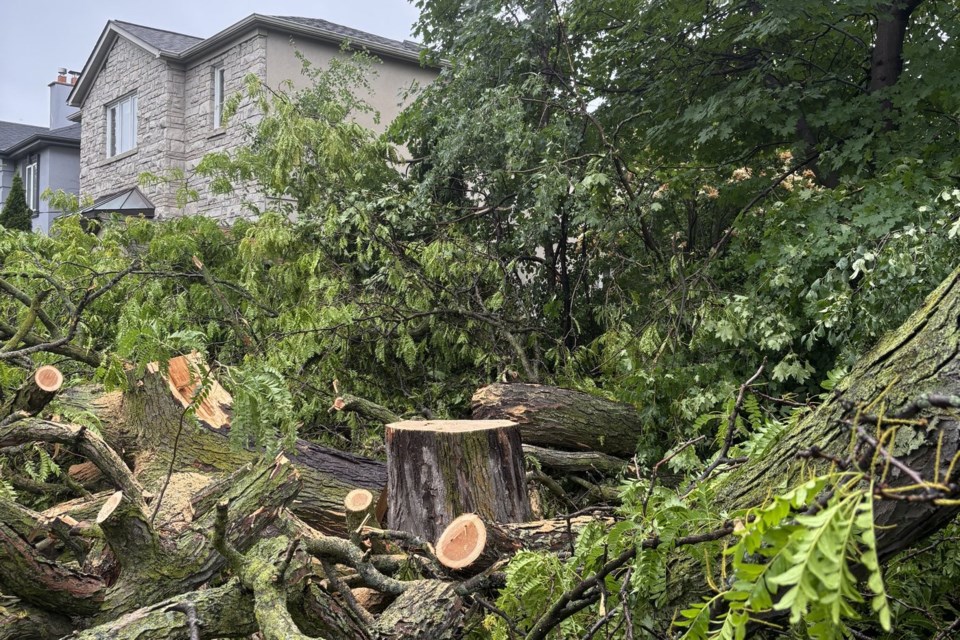TORONTO — The big, backyard honey locust had a seating area set up under its canopy and a swing hanging from a sturdy branch.
It was one of many trees in Leaside, a residential neighborhood northeast of downtown Toronto that is famous for its old growth and green space, but it was special, says Karen Hwang.
It was nothing short of an "oasis" for her neighbour, who liked to entertain in the backyard. It also benefited Hwang's family next door from the time they moved in 34 years ago, supplying fresh air and blocking noise pollution.
"That tree provided, you know, the wonderful shade, the beautiful esthetic," she recalled in a recent interview.
"It just had so many positive environmental impacts."
Without the city's permission, the beloved giant was recently brought down, in a case that has sparked neighbourhood outrage and calls for change at city hall.
On the morning of June 26, Hwang said she and her husband were eating breakfast while watching the news when they heard a "big bang" and their television screen went dark.
The couple rushed outside to check what happened, and they saw the tree was being cut down, and a big branch had hit their satellite dish.
At the time, developer Modcity was preparing to build a fourplex and garden suite on the property after Hwang's neighbour sold her house.
The city confirmed there was no permit to remove the tree before construction began. It said it has launched an investigation.
The Canadian Press made several unsuccessful attempts to reach Modcity for comment, including email inquiries and a visit to a location listed on its website as the company's address.
Privately owned trees with a diameter of 30 centimetres or more are protected under the city's tree protection bylaw. The diameter of the one removed was closer to 80 centimetres, according to neighbors.
Kim Statham, the city's director of urban forestry, said there was an application to remove a privately owned tree in October, and city staff worked with the builder for five months to revise the multiplex’s design to protect the tree.
"The revised tree-friendly multiplex design created a minor variance that was approved by the Committee of Adjustment," Statham said.
"The honey locust tree was to remain and not be removed."
Rachel Chernos Lin, the councillor representing the area, said the intent was to protect the tree by moving the building's footprint onto the front yard closer to the street.
The developer removed the tree anyway without the city's support. And to add insult to injury, Lin said, the developer applied to place a parking pad where the tree had stood.
For community members, the idea of paving a little piece of paradise to put in a parking spot was a bridge too far.
"People feel like (the developer) has really taken advantage of the system and disregarded the rules, and people really care and are very angry about that," Lin said.
Currently, the offence of removing a tree without a permit can carry a fine between $500 and $100,000. It has no impact on permits issued under Ontario's Building Code.
The current fine structure is not enough to disincentivize the practice, Lin said.
On Thursday, city council adopted a motion Lin proposed that would make tree removal more difficult and add "additional tools" to protect the city's tree canopy.
The motion requests that the provincial Ministry of Municipal Affairs and Housing add the tree bylaw as an applicable law for the purposes of issuing building permits.
It also suggests repeat offenders be named and shamed publicly.
City staff are expected to report back about progress towards achieving these goals by the end of the year.
"I want to make sure this doesn't happen again," said Lin.
Geoff Kettel, co-president of the Leaside Residents Association, said the builder should not be able to use the revised footprint after taking out the tree that the new design was meant to protect.
The supposed compromise allowed the builder to put the multiplex more than two metres closer to the sidewalk, and Kettel said neighbours' bungalows and two-storey homes are now at greater risk of being overshadowed.
"If they destroyed the reason for moving it forward in the first place, there's now no reason to move it forward," he said.
"People should be obeying the law. They should be doing it right, following the best practices," he added. "It's very, very disappointing."
Last week, The Canadian Press visited the construction site, where a concrete foundation had been laid and tree roots were still visible under a pile of soil.
Elizabeth Marsden and her friend Ann Aveling walked by the area and stopped to comment on the tree's unfortunate fate.
"It was a beautiful, big red locust and there are not many red locusts," said Marsden who has lived in the neighborhood for four decades.
"It was just a lovely tree," she said. "I was angry. How dare they?"
She said she thinks the fines given to builders for such violations are "peanuts," and there needs to be better enforcement.
Aveling said the uprooting was "totally unnecessary" and it made her feel sad, especially as the life cycle of many other trees in the neighbourhood is coming to a natural end.
"What drew us to Leaside 40 years ago was the trees, the tree canopy, and you'd have these beautiful shaded streets," she said.
"Which of course we're now losing."
This report by The Canadian Press was first published July 26, 2025.
Sharif Hassan, The Canadian Press



